Salon
The BagNews Campaign Mania Salon
Sponsored by Open-i
The BagNewsSalon, a program of BagNewsNotes, brings together the world’s leading photojournalists, visual academics and other informed observers to to analyze a 9 photo edit (“9 photos in 90 minutes”) in order to understanding how the visual media frames the key social and political events of the day.
On January 29th, in collaboration with Open-i, the BagNews Salon hosted “Campaign Mania,” an early look at the 2012 presidential campaign.
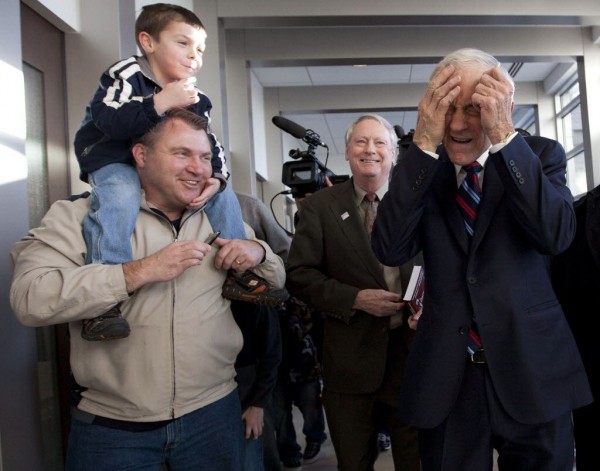
Images and Selected Quotes
Co-Produced for BagNews by Ida Benedetto
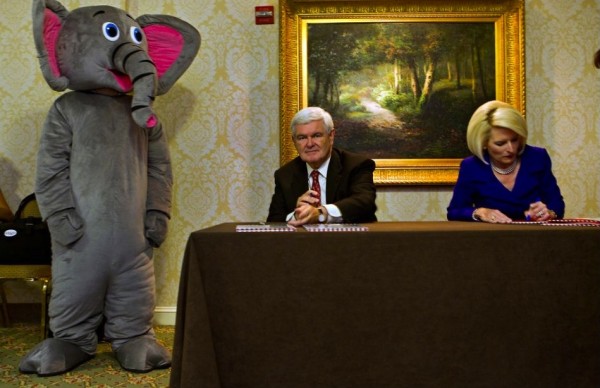
(photo: Stephen Crowley / The New York Times caption: Newt Gingrich and his wife, Callista, signed books at the Values Voter Summit in Washington in October.)
Nina: I can’t seem to take my eyes away form the elephant. I love how it’s pictured as the character of authority in this picture. At least that what it seems to me. It’s standing there almost in judgement, and so, of course it’s kind of a clever device to have such a comical figure as a representative of the Republican Party, as something of a figure of authority.
Brendan: With this elephant off in the corner, the plasticity of the scene and the Gingrich gaze, the impression to me is of Gingrich realizing that he’s been caught in the act of something. I think he realizes it. Maybe there’s this shared moment with the viewer; an understanding that maybe this whole thing is a little absurd.
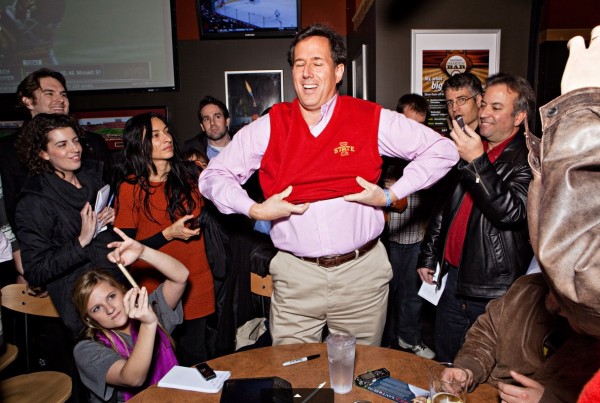
(photo: Lars Tunbjork / for TIME. caption: A Stranger in a Strange Land: The Iowa Caucus.)
Justin: I’m sure he doesn’t care about Iowa state athletics, but I guess he felt like if he did this he would appeal more to this audience. It’s a strange facet to take on (the trappings of) wherever you are. Does he do that in New Hampshire? Does he try to appeal to people in Dartmouth by wearing Dartmouth sweaters? I thought it was interesting aspect to his campaign strategy.
Brendan: For those who are fully immersed in the campaign, the sweater vest has become a trademark of Santorum. He literally wears a sweater vest every day with his name embroidered on it. In some way, this was an inside joke, or a way to bond with him. Whoever bought it for him to put on knew that it would get this level of attention. People just really want to engage in the campaign on some goofy level that way.
Nina: Isn’t the … narrative of the Iowa Caucus and these early moments in the campaigns more about how ridiculous these candidates can appear, and the strange things we ask of them to do, and if they can survive this … process of ongoing humiliation, too, that’s of course photographed not just by the press, but everybody else around them, (and) if they can actually endure this process, that’s (how) we … decide what will make them capable of enduring and winning the presidency.
Cara: I think that term humiliation is a really interesting one, how he’s being kind of used as a mannequin here, it’s what you put on it’s not really what you say.
Cara: What if we cut the elephant out of the earlier picture and placed it next to Santorum? Would we find an analogy there to that silliness, the performing the circus quality?

(photo: Chip Somodevilla / Getty Images. caption: Former Massachusetts Governor and Republican presidential candidate Mitt Romney stands in a chair as campaign staff member Garrett Jackson holds it steady during a campaign event at Music Man Square December 29, 2011 in Mason City, Iowa. Recent state-wide polls put Romney and fellow candidate Rep. Ron Paul (R-TX) close going into next week’s first-in-the-country Iowa Caucuses, a litmus test for the GOP hopefuls.)
Janis: We so infrequently see what I would call backstage pictures of campaigns; the artifice of things like standing on risers, having to think quickly about an appearance… This really captures that. We see the staging. We see the effort that goes into it. It also positions the candidate more easily to a certain conventions of photography, especially political photography, where the candidate is levitated before other people, particularly the journalist.
Nina: I was interested in how he relates to the man with the cane sitting down. Most of the people the audience are senior citizens and could not probably stand on a chair like that.
Lorette: He’s in jeans and shirt sleeves. He’s normal enough to leap up on a chair and utilitarian enough to be able to do that. He seems to be very spontaneous. He’s taking some risk because those chairs are not very stable, but the cynical person in me also has to ask the question is he faking this I’m one of you spontaneous moments.
Justin: To continue on that same vein, it does seem like this totally organic and genuine appeal to these voters by standing on this chair is a very 1950s approach to politics. At the same time, you have this studio light in the back, which shows that it’s really fake. It’s set up like a stage. Maybe it was even planned. They saw this opportunity to use it a s a prop that would resonate with these voters, and it would show he was one of them. He was some one they could identify with on a more folksy level.
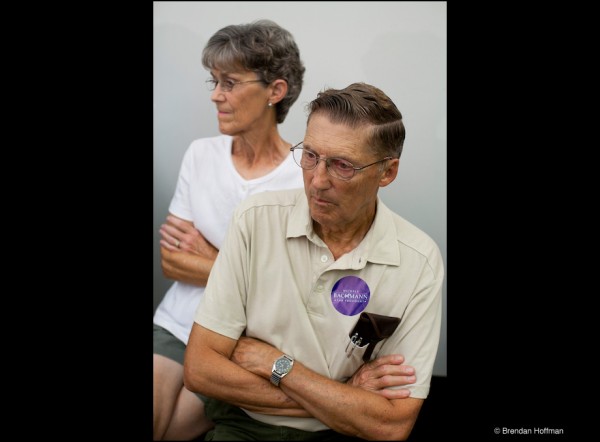
(photo: Brendan Hoffman / Prime Collective. caption: Attendees at a town hall meeting held by Republican presidential hopeful Michele Bachmann on Saturday, July 23, 2011 in Marshalltown, IA.)
Brendan: I was intrigued by aparent skepticism they were displaying. A theme I was interested in going into campaign coverage was whether the voters who show up for these events felt like were actually getting the level of substance that they were hoping for when they hear candidates speak.
Nina: What’s so surprising is we don’t see voters in the act of really considering a candidate too often. What’s unusual is that Bachman is presenting herself in such this insane way that I would never take these people for Bachman supporters. I guess that’s the tension I find in the picture. I have my image of Bachman but then looking at them and they seem like quite serious very sober people, really trying to understand what’s happening.
Brendan: I don’t think you can just automatically assume that they are supporters. It’s Iowa and people are very polite. You walk into one of these events and a volunteer hands you a sticker. The vast majority are just going to put it on just to be polite. From the picture, it’s really impossible to tell whether they were there just to suss out their options or whether they were on the Bachman bandwagon.

(photo: Evan Vucci / AP. caption: Republican presidential candidate Rep. Ron Paul, R-Texas, jokes with a father and son during a campaign stop on Monday, Jan. 2, 2012, in Cedar Rapids, Iowa.)
Michael: The general population sees Ron Paul as a bit of a outlier. Looking clownish here, he’s kind of eliciting that. It makes me wonder in a larger sense how savvy Ron Paul is. I have to imagine he’s quite ware of the way that people talk about him and treat him. He makes jokes about that. I wonder if he’s playing to that a little bit and that he isn’t quite shrewd about the way he’s interpreted.
Justin: He would go around the event surrounded by media as he walked in, do a talk and he would leave. It was rare that he would stop and even shakes hands with people. It was surreal because you almost expect a fellow who wants to be in office to really want to have a personal connection with the people that he’s hoping will vote for him. Given that, I think this is a pretty shining moment for him because very few times have seen him smile or seem like a human being. He seemed like this guy who had a mission to go speak and that was it.
Janis: He has been the invisible candidate in so many ways. This photo actually shows a voter with him. I’ve been studying post debate pictures and even in some of those, Ron Paul is excluded from the scene whereas the other three candidates are visible. So first of all there’s the fact that there is a picture at all, second that it includes a voter and his son, and third that it is a humanizing, quite amusing picture with everyone having a positive response.
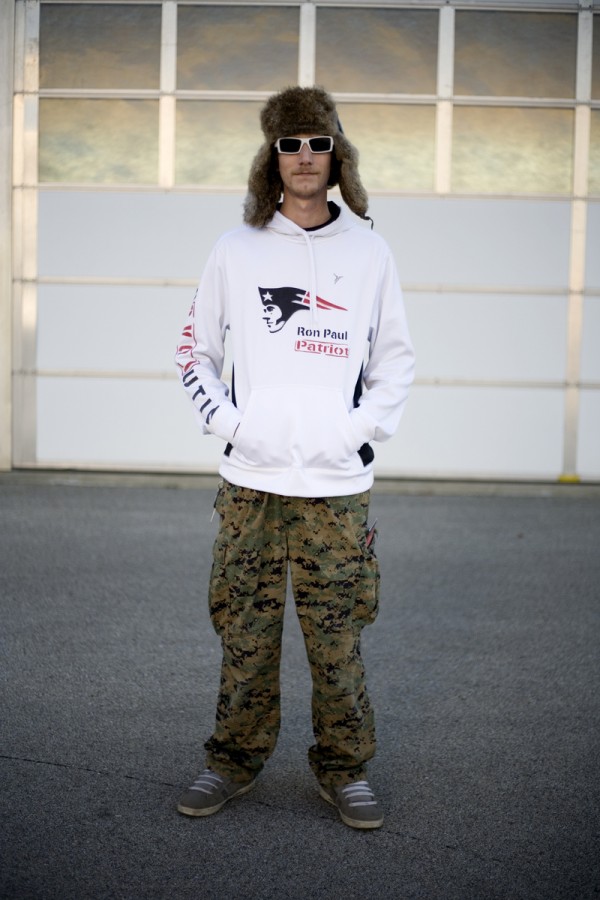
(photo: M. Scott. caption: Ron Paul supporter Mitch Winn, 24, of Sandown, New Hampshire, poses for a portrait after a Ron Paul rally at Jet Aviation in Nashua, New Hampshire, on Jan. 6, 2012. Paul is seeking the 2012 GOP Republican presidential nomination.)
Cara: I think three themes in this photo really leap out at me in terms of links to previous photographs we’ve looked at. We’ve got a guy wearing a Ron Paul patriot sweat shirt that has a link to sports and athletics. Obviously there’s political support. We’ve also got an image of a voter but this time a voter in isolation.
Brendan: What I find interesting about this photograph is that this guy seems like a stereotypical Ron Paul voter; a 20 something male. The glasses and the hat and the camouflage pants kind of peg him as a little out there. I’ve also noticed at his campaign events it’s really hard to pinpoint out a stereotypical Ron Paul supporter. They seem to be one of the most diverse groups of all the candidates so it’s curious in a way that this would become the con of the Ron Paul supporter.
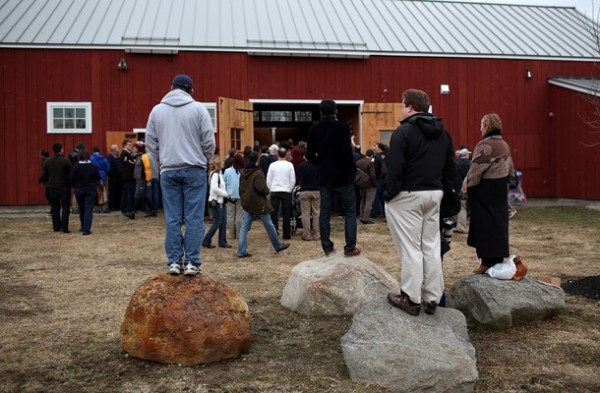
(photo: Justin Sullivan / Getty Images. caption: An overflow crowd stands outside of the Lawrence Barn as Republican presidential candidate, former U.S. Sen. Rick Santorum speaks during a Faith, Family and Freedom town hall meeting on January 7, 2012 in Hollis, New Hampshire. With less than one week before the New Hampshire primary, Rick Santorum continues to campaign in New Hampshire.)
Justin: Once you reach this level in popularity, your events go form 0 to 100 over night. Santorum saw that in Iowa. He was nobody. Just overnight, he became a sensation. Everybody refocused their attention on either covering him or going to try and see him to figure out if they wanted to vote for him. The overflow actually created some nice pictures. There’s a few pictures from the event that showed a different side of covering a campaign.
Lorette: The message and the content here would not be told as much if you had a close up with a 400 millimeter lens of Santorum speaking. What you’re actually showing is that this guy is pulling in crowds and these people actually want to see him and hear him and their making that effort event in it means standing out in the cold.
Michael: Wanted to ask Justin if he was going to some humor or novelty with this shot and to what extent was what his thought process in the moment as opposed to what the edit was later. I’m going both ways. There’s also something statuesque about this in the way that people were on top of the rocks. I’m wondering what was in your mind Justin at the time, and then afterwards.
Justin: I like your analogy of being set in stone. I did think that they looked like statues, and I liked the way that they next to each other and there was a little bit a of space and it was almost like a formation.
Janis: I can’t help noting that within the images we’re looking at today that this is such a lovely counterpoint to the Mit Romney on the chair.
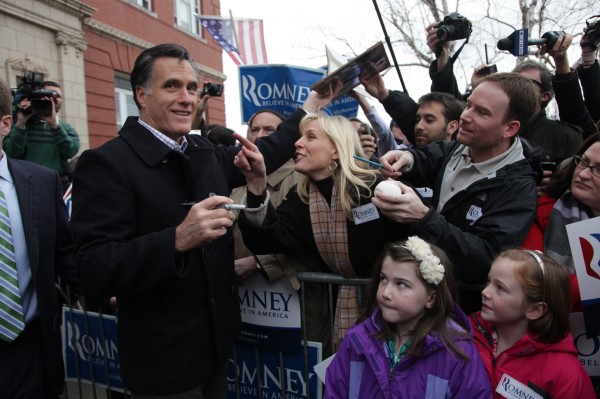
(photo: Jim Wilson / The New York Times. caption: Mitt Romney greeted supporters outside the Rochester Opera House in Rochester, N.H.)
Lorette: This image looks very much like an advertizing shot. She has that playful assertive attitude and he’s the goofy guy who’s just reacting to her. It looks incredibly staged with advertising visual language.
Michael: At the Bag, we’ve been continually fascinated watching the pictures come in week after week about Romney’s inability to carry a photo. The one guy who really seems to be able to feed off that and understand that is Jim Wilson who took this photo. He’s really been successful here in adding so much content to supplement Romney and this is sort of a wonderful example. This looks like they stocked this photo from central casting. It’s like calling up and saying, ‘Alright we need an attractive blonde woman we’re going to stick her right in the middle of the photo how bout baseball let’s do something with baseball. Yeah, and then we could get some really attractive kids. Yeah lets get a couple of kids.’ Then they just populated the photo and built this around him.
Brendan: That’s the Adbusters flag in the background. I don’t know if I have anything to read into it per say accept the fact that perhaps some of the occupy folks were in the background somewhere. I’m sure all of you have seen this flag where the stars are replaced with corporate logos. That’s what we see back there.
Justin: The guy holding a base balls reaching out for the autograph seems like the thorn in the Romney campaign’s side. There’s all these autograph seekers turning them into sales on e-bay. If there are people who have baseballs or pictures or stuff like that there’s just no engagement, no shaking their hand, no talking with them. He just sort of signs the thing and moves on. I’m wondering if this guy is actually a voter or it’s just another one of the autograph hands trying to make a buck.
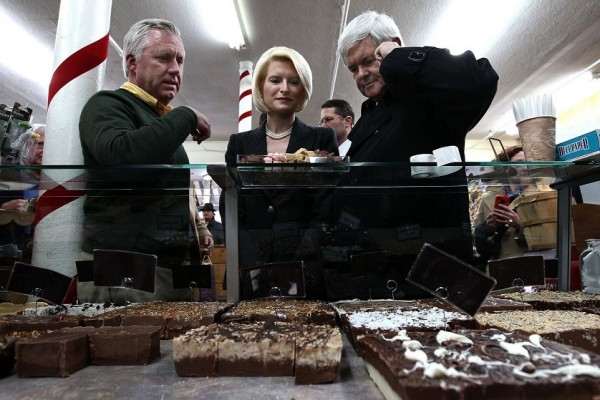
(photo: Win McNamee / Getty. caption: Republican presidential candidate, former Speaker of the House Newt Gingrich (R) and his wife Callista (C) browse fudge samples with owner Jim Alden (L) while visiting Chutters Candy Shop – home of the ‘World’s Largest Candy Counter’ – during a short tour of Main Street January 5, 2012 in Littleton, New Hampshire. After finishing 4th in the Iowa Caucus, Gingrich continued his campaign in New Hampshire for the upcoming, first in the nation primary.)
Janis: Wives on the campaign trail are common, but I haven’t seen a constant stream of picture with the wife just glued to the candidate as I have with Gingrich. I like this photo both for an original point of view, but here’s the one that centered the candidates spouse.
Cara: I’ve noticed in clips of his stump speeches and appearances that he invokes her verbally all the time. It’s ‘Callista and I….’ Maybe the visual and the rheological are working together.
Nina: It’s not because I’m not a fudge lover, but I was struck by how unappetizing it all looked and that this isn’t really a cookie they want to put their hands in. It’s a nice picture symbolically with the temptation after the sweets and all that, but the whole look of it seems below Callista’s pearls, not quite up to her standard.
The Full Edit
Take a closer look at some of the images from our larger photo edit.









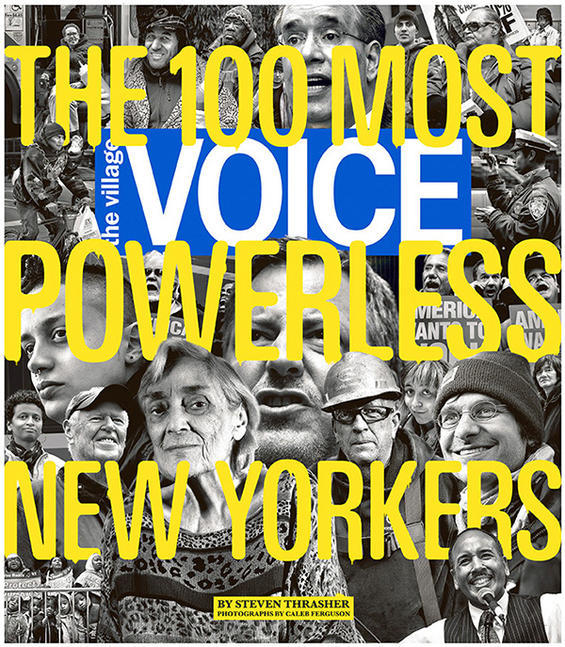
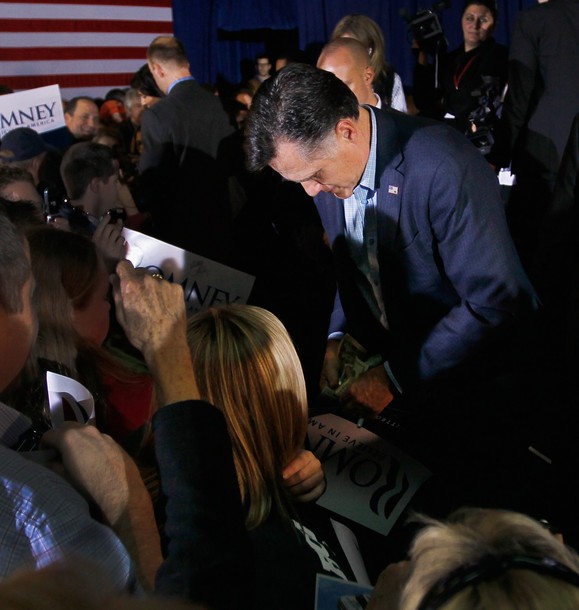
Reactions
Comments Powered by Disqus